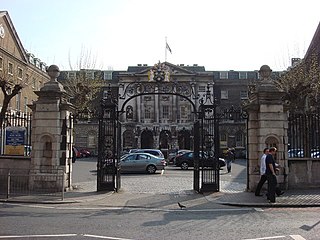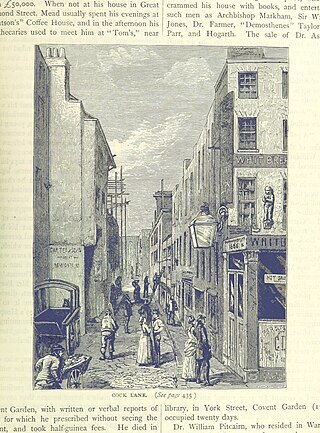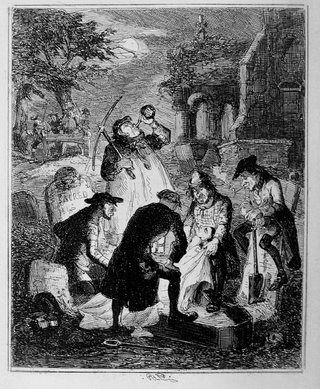
A mince pie is a sweet pie of English origin filled with mincemeat, being a mixture of fruit, spices and suet. The pies are traditionally served during the Christmas season in much of the English-speaking world. Its ingredients are traceable to the 13th century, when returning European crusaders brought with them Middle Eastern recipes containing meats, fruits, and spices; these contained the Christian symbolism of representing the gifts delivered to Jesus by the Biblical Magi. Mince pies, at Christmas time, were traditionally shaped in an oblong shape, to resemble a manger and were often topped with a depiction of the Christ Child.

The Report of the Departmental Committee on Homosexual Offences and Prostitution was published in the United Kingdom on 4 September 1957 after a succession of well-known men, including Lord Montagu of Beaulieu, Michael Pitt-Rivers, John Gielgud, and Peter Wildeblood were convicted of homosexual offences.

Guy's Hospital is an NHS hospital founded by Thomas Guy, located in the borough of Southwark in central London. It is part of Guy's and St Thomas' NHS Foundation Trust and one of the institutions that comprise the King's Health Partners, an academic health science centre.

Body snatching is the illicit removal of corpses from graves, morgues, and other burial sites. Body snatching is distinct from the act of grave robbery as grave robbing does not explicitly involve the removal of the corpse, but rather theft from the burial site itself. The term 'body snatching' most commonly refers to the removal and sale of corpses primarily for the purpose of dissection or anatomy lectures in medical schools. The term was coined primarily in regard to cases in the United Kingdom and United States throughout the 17th, 18th, and 19th centuries. However, there have been cases of body snatching in many countries, with the first recorded case dating back to 1319 in Bologna, Italy.

The Golden Boy of Pye Corner is a small late-17th-century monument located on the corner of Giltspur Street and Cock Lane in Smithfield, central London. It marks the spot where the 1666 Great Fire of London was stopped, whereas the Monument indicates the place where it started. The statue of a naked boy is made of wood and is covered with gold; the figure was formerly winged. The late 19th-century building that incorporates it is a Grade II listed building but listed only for the figure.
There are a number of passages in the Hebrew Bible and the New Testament that have been interpreted as involving same-sex sexual activity and relationships. The passages about homosexual individuals and sexual relations in the Hebrew Bible are found primarily in the Torah. The book of Leviticus chapter 20 is more comprehensive on matters of detestable sexual acts. Some texts included in the New Testament also reference homosexual individuals and sexual relations, such as the Gospel of Matthew, the Gospel of Luke, and Pauline epistles originally directed to the early Christian churches in Asia Minor. Both references in the Hebrew Bible and the New Testament have been interpreted as referring primarily to male homosexual individuals and sexual practices, though the term homosexual was never used as it was not coined until the 19th century.
Golden Boy or The Golden Boy may refer to:
The London Burkers were a group of body snatchers operating in London, England, who apparently modeled their activities on the notorious Burke and Hare murders. They came to prominence in 1831 for murdering victims to sell to anatomists, by luring and drugging them at their dwelling in the northern end of Bethnal Green, near St Leonard's, Shoreditch in London. They were also known as the Bethnal Green Gang.

Giltspur Street is a street in Smithfield in the City of London, England, running north–south from the junction of Newgate Street, Holborn Viaduct and Old Bailey, up to West Smithfield, and it is bounded to the east by St Bartholomew's Hospital. It was formerly known as Knightsriders Street, from the knights riding at the tournaments in Smithfield.

A meat pie is a pie with a filling of meat and often other savory ingredients. They are found in cuisines worldwide.

The Paedophile Information Exchange (PIE) was a British pro-paedophile activist group, founded in October 1974 and officially disbanded in 1984. The group campaigned for the abolition of the age of consent. It was described by the BBC in 2007 as "an international organisation of people who trade obscene material".

Richard Partridge FRS, FRCS was a British surgeon. Although he became President of both the Royal College of Surgeons and the Royal Medical and Chirurgical Society, he is best known for his part in apprehending the London Burkers gang and for failing to spot a bullet lodged in Giuseppe Garibaldi's leg.

The Machine Gun Corps Memorial, also known as The Boy David, is a memorial to the casualties of the Machine Gun Corps in the First World War. It is located on the north side of the traffic island at Hyde Park Corner in London, near the Wellington Arch, an Equestrian statue of the Duke of Wellington, the Royal Artillery Memorial, the New Zealand War Memorial, and the Australian War Memorial.

Cock Lane is a small street in Smithfield in the City of London, leading from Giltspur Street in the east to Snow Hill in the west.

Resurrectionists were body snatchers who were commonly employed by anatomists in the United Kingdom during the 18th and 19th centuries to exhume the bodies of the recently dead. Between 1506 and 1752 only a very few cadavers were available each year for anatomical research. The supply was increased when, in an attempt to intensify the deterrent effect of the death penalty, Parliament passed the Murder Act 1752. By allowing judges to substitute the public display of executed criminals with dissection, the new law significantly increased the number of bodies anatomists could legally access. This proved insufficient to meet the needs of the hospitals and teaching centres that opened during the 18th century. Corpses and their component parts became a commodity, but although the practice of disinterment was hated by the general public, bodies were not legally anyone's property. The resurrectionists therefore operated in a legal grey area.

The Salisbury is a Grade II listed public house at 91–93 St Martin's Lane, Covent Garden, London which is noted for its particularly fine late Victorian interior with Art Nouveau elements.

The Red Lion is a Grade II listed public house at 48 Parliament Street, London SW1. The pub is known for its political clientele and has been described as "the usual watering hole for MPs and parliament staffers" and "much-plotted-in" due to its proximity to UK political institutions including Whitehall, the Palace of Westminster, and 10 Downing Street.

The Greene Man is a public house in London's Euston Road. It was formerly known as the Green Man and before that, the Farthing Pie House or Pye House as mutton pies could be bought there for a farthing. When it was established in the 18th century, the area was rural and so the surroundings were farm fields and pleasure gardens. The place was then frequented by notable artists and writers including William Blake and Richard Wilson.

Chiswick High Road is the principal shopping and dining street of Chiswick, a district in the west of London. It was part of the main Roman road running west out of London, and remained the main road until the 1950s when the A4 was built across Chiswick. By the 19th century the road through the village of Turnham Green had grand houses beside it. The road developed into a shopping centre when Chiswick became built up with new streets and housing to the north of Old Chiswick, late in the 19th century. There are several listed buildings including public houses, churches, and a former power station, built to supply electricity to the tram network.
















